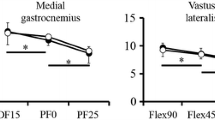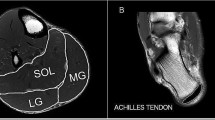Abstract
Purpose
In many sports, athletes have a preferred leg for sport-specific tasks, such as jumping, which leads to strength differences between both legs, yet the underlying changes in force-generating mechanical properties of the muscle remain unknown. The purpose of this study was to investigate whether the muscle architecture of the medial gastrocnemius (MG) is different between both legs in well-trained jumping athletes and untrained individuals. In addition, we investigated the effect of two ankle joint positions on ultrasound muscle architecture measurements.
Methods
Muscle architecture of both legs was measured in 16 athletes and 11 untrained individuals at two ankle joint angles: one with the ankle joint in a tendon slack length (TSL) angle and one in a 90° angle.
Results
Fascicle lengths and pennation angles at TSL were not different between the preferred and non-preferred legs in either group. The comparison between groups showed no difference in fascicle length, but greater pennation angles were found in the athletes (21.7° ± 0.5°) compared to the untrained individuals (19.8° ± 0.6°). Analyses of the muscle architecture at a 90° angle yielded different results, mainly in the comparison between groups.
Conclusion
These results provide only partial support for the notion of training-induced changes in muscle architecture as only differences in pennation angles were found between athletes and untrained individuals. Furthermore, our results provide support to the recommendation to take into account the tension–length relationship and to measure muscle architecture at individually determined tendon slack joint angles.



Similar content being viewed by others
Abbreviations
- ANOVA:
-
Analysis of variance
- ICC:
-
Intra-class correlations
- MG:
-
Medial gastrocnemius
- MTU:
-
Muscle–tendon unit
- SEM:
-
Standard errors of measurement
- TSL:
-
Tendon slack length
References
Aagaard P, Andersel JL, Dyhre-Poulsen P, Leffers AM, Wagner A, Magnusson SP, Halkiaer-Kristensen J, Simonsen EB (2001) A mechanism for increased contractile strength of human pennate muscle in response to strength training: changes in muscle architecture. J Physiol 534:613–623
Abe T, Kumagai K, Brechue WF (2000) Fascicle length of leg muscles is greater in sprinters than distance runners. Med Sci Sports Exerc 32:1125–1129
Abe T, Fukashiro S, Harada Y, Kawamoto K (2001) Relationship between sprint performance and muscle fascicle length in female sprinters. J Physiol Anthropol 20:141–147
Arampatzis A, Karamanidis K, Morey-Klapsing G, De Monte G, Stafilidis S (2007) Mechanical properties of the triceps surae tendon and aponeurosis in relation to intensity of sport activity. J Biomech 40:1946–1952
Blazevich AJ (2006) Effects of physical training and detraining, immobilization, growth and aging on human fascicle geometry. Sports Med 36:1003–1017
Blazevich AJ, Giorgi A (2001) Effect of testosterone administration and weight training on muscle architecture. Med Sci Sports Exerc 33:1688–1693
Blazevich AJ, Gill ND, Bronks R, Newton RU (2003) Training-specific muscle architecture adaptations after 5-wk training in athletes. Med Sci Sports Exerc 35:2013–2022
Blazevich AJ, Gill ND, Deans N, Zhou S (2007) Lack of human muscle architectural adaptation after short-term strength training. Muscle Nerve 35:78–86
Bolsterlee B, Veeger HEJ, van der Helm FCT, Gandevia SC, Herbert RD (2015) Comparison of measurements of medial gastrocnemius architectural parameters from ultrasound and diffusion tensor images. J Biomech 48:1133–1140
Close RI (1972) Dynamic properties of mammalian skeletal muscles. Physiol Rev 52:129–197
Cronin NJ, Avela J, Finni T, Peltonen J (2013) Differences in contractile behaviour between the soleus and medial gastrocnemius muscles during human walking. J Exp Biol 216:909–914
De Groote F, De Laet T, Jonkers I, De Schutter J (2008) Kalman smoothing improves the estimation of joint kinematics and kinetics in marker-based human gait analysis. J Biomech 41:3390–3398
Delp SL, Anderson FC, Arnold AS, Loan P, Habib A, John CT, Guendelman E, Thelen DG (2007) OpenSim: open-source software to create and analyze dynamic simulations of movement. IEEE Trans Biomed Eng 54:1940–1950
Farris DJ, Lichtwark GA (2016) Ultratrack: software for semi-automated tracking of muscle fascicles in sequences of B-mode ultrasound images. Comput Methods Programs Biomed 128:111–118
Farris DJ, Lichtwark GA, Brown NAT, Cresswell AG (2016) The role of human ankle plantar flexor muscle–tendon interaction and architecture in maximal vertical jumping examined in vivo. J Exp Biol 219:528–534
Franchi MV, Atherton PJ, Reeves ND, Flück M, Williams J, Mitchell WK, Selby A, Beltran Valls RM, Narici MV (2014) Architectural, functional and molecular responses to concentric and eccentric loading in human skeletal muscle. Acta Physiol (Oxf) 210:642–654
Gerus P, Rao G, Berton E (2014) Ultrasound-based subject-specific parameters improve fascicle behaviour estimation in Hill-type muscle model. Comput Methods Programs Biomed 18:116–126
Grace TG, Sweetser ER, Nelson MA (1984) Isokinetic muscle imbalance and knee-joint injuries. J Bone Joint Surg 66:734–739
Hamner SR, Seth A, Delp SL (2010) Muscle contributions to propulsion and support during running. J Biomech 43:2709–2716
Hill AV (1938) The heat of shortening and the dynamic constants of muscle. Proc R Soc Lond B Biol Sci 126:136–195
Hoang PD, Herbert RD, Todd G, Gorman RB, Gandevia SC (2007) Passive mechanical properties of human gastrocnemius muscle–tendon units, muscle fascicles and tendon in vivo. J Exp Biol 210:4159–4168
Karamanidis K, Arampatzis A (2006) Mechanical and morphological properties of human quadriceps femoris and tricpes surae muscle–tendon unit in relation to aging and running. J Biomech 39:406–4017
Karamanidis K, Albracht K, Braunstein B, Catala MM, Goldmann JP, Brüggemann GP (2011) Lower leg musculoskeletal geometry and sprint performance. Gait Posture 34:138–141
Kawakami Y, Abe T, Kuno SY, Fukunaga T (1995) Training-induced changes in muscle architecture and specific tension. Eur J Appl Physiol 72:37–43
Knapik JJ, Boumann CL, Jones BH, Harris JM, Vaughan L (1991) Pre-season strength and flexibility imbalances associated with athletic injuries in female collegiate athletes. Am J Sports Med 19:76–81
Kumugai K, Abe T, Brechue WF, Ryushi T, Takano S, Mizuno M (2000) Sprint performance is related to muscle fascicle length in male 100-m sprinters. J Appl Physiol 88:811–816
Kwah LK, Pint RZ, Diong J, Herbert RD (2013) Reliability and validity of ultrasound measurements of muscle fascicle length and pennation in humans: a systematic review. J Appl Physiol 114:761–769
Lai A, Lichtwark GA, Schache AG, Lin YC, Brown NAT, Pandy MG (2015) In vivo behavior of the human soleus muscle with increasing walking and running speeds. J Appl Physiol 118:1266–1275
Lichtwark GA, Wilson AM (2006) Interactions between the human gastrocnemius muscle and the Achilles tendon during incline, level and decline locomotion. J Exp Biol 209:4379–4388
Lichtwark GA, Wilson AM (2008) Optimal muscle fascicle length and tendon stiffness for maximising gastrocnemius efficiency during human walking and running. J Theor Biol 252:662–673
Luk HY, Winter C, O’Neill E, Thompson BA (2014) Comparison of muscle strength imbalance in powerlifters and jumpers. J Strength Cond Res 28:23–27
Mangine GT, Hoffman JR, Gonzalez AM, Jajtner AR, Scanlon T, Rogowski JP, Wells AJ, Fragala MS, Stout JR (2014) Bilateral differences in muscle architecture and increased rate of injury in national basketball association players. J Athl Train 49:794–799
Newton RU, Gerber A, Nimphius S, Shim JK, Doan BK, Robertson M, Pearson DR, Craig BW, Häkkinen K, Kraemer WJ (2006) Determination of functional strength imbalance of the lower extremities. J Strength Cond Res 20:971–977
Nimphius S, McGuigan MR, Newton RU (2012) Changes in muscle architecture and performance during a competitive season in female softball players. J Strength Cond Res 26:2655–2666
Owens EM, Serrano AJ, Ramsey MW, Mizuguchi S, Johnston B, Stone MH (2011) Comparing lower-limb asymmetries in NCAA D-I male and female athletes. J Strength Cond Res 25:44–45
Passmore E, Lai A, Sangeux M, Schache AG, Pandy MG (2016) Application of ultrasound imaging to subject-specific modelling of the human musculoskeletal system. Meccanica 52:665–676
Reeves ND, Maganaris CN, Longo S, Narici MV (2009) Differential adaptations to eccentric versus conventional resistance training in older humans. Exp Physiol 94:825–833
Rutherford OM, Jones DA (1992) Measurement of fibre pennation using ultrasound in the human quadriceps in vivo. Eur J Appl Physiol 65:433–437
Sannicandro I, Piccinno A, Rosa RA, De Pascalis S (2011) Functional asymmetry in the lower limb professional soccer players. J Sports Med 45:370
Sano K, Ishikawa M, Nobue A, Danno Y, Akiyama M, Oda T, Ito A, Hoffren M, Nicol C, Locatelli E, Komi PV (2013) Muscle–tendon interaction and EMG profiles of world class endurance runners during hopping. Eur J Appl Physiol 113:1395–1403
Timmins RG, Ruddy JD, Presland J, Maniar N, Shield AJ, Williams MD, Opar DA (2016) Architectural changes of the biceps femoris after concentric or eccentric training. Med Sci Sports Exerc 48:499–508
Vernillo G, Pisoni C, Sconfienza LM, Thiébat G, Longo S (2017) Changes in muscle architecture of vastus lateralis muscle after an alpine snowboarding race. J Strength Cond Res 31:254–259
Zajac FE (1989) Muscle and tendon: properties, models, scaling and application to biomechanics and motor control. Crit Rev Biomed Eng 17:359–411
Acknowledgements
The authors gratefully thank Dr. Charlotte Waugh for her help with data collection.
Author information
Authors and Affiliations
Corresponding author
Ethics declarations
Conflict of interest
The authors declare that they have no conflict of interest.
Ethical approval
All procedures performed in this study were in accordance with the ethical standards of an independent ethical committee and with the 1964 Helsinki declaration and its later amendments or comparable ethical standards.
Additional information
Communicated by Olivier Seynnes.
Rights and permissions
About this article
Cite this article
Aeles, J., Lenchant, S., Vanlommel, L. et al. Bilateral differences in muscle fascicle architecture are not related to the preferred leg in jumping athletes. Eur J Appl Physiol 117, 1453–1461 (2017). https://doi.org/10.1007/s00421-017-3638-5
Received:
Accepted:
Published:
Issue Date:
DOI: https://doi.org/10.1007/s00421-017-3638-5




